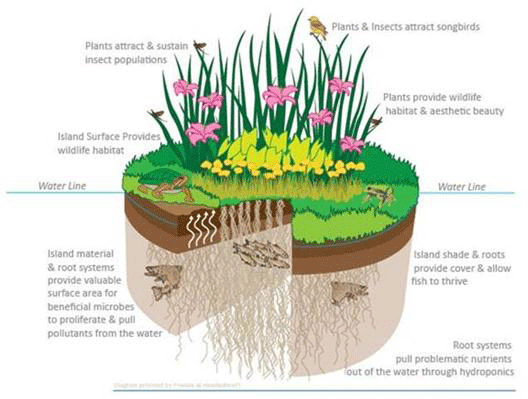Minnesota Landscape Architects to install ‘floating Islands’ in impaired Minneapolis lake
FOR IMMEDIATE RELEASE
Minnesota Landscape Architects to install ‘floating Islands’ in impaired Minneapolis lake
MINNEAPOLIS (August 9, 2011) – On August 17, 2011, the American Society of Landscape Architects (ASLA) is launching a campaign to raise public awareness and understanding of the landscape architecture profession. A coordinated launch will take place among ASLA chapters in all 50 states, and the Minnesota Chapter (ASLA-MN) is undertaking one of the most ambitious events in the nation by launching seven “floating islands” on an impaired lake in Minneapolis.
Spring Lake, located in the Lowry Hill Neighborhood between I-394 and Kenwood Parkway, was acquired by the Minneapolis Park and Recreation Board (MPRB) as a wildlife refuge in 1893. Since then, it has become a severely impaired body of water with a shoreline and park ridden with invasive species. This year, ASLA-MN partnered with the Lowry Hill Neighborhood Association (LHNA) to analyze ways to revitalize Spring Lake and its surrounding park. LHNA allocated funds to restore the area to its original designation as a bird and wildlife sanctuary and pledged to have the area removed from the Impaired Waters List of the Minnesota Pollution Control Agency’s Clean Water Act. The group’s plan includes design and installation of seven floating islands that will improve water quality, attract beneficial plant and animal species and help to restore the lake to a livable fishing habitat.
These islands, known as floating treatment wetlands (FTWs), are powerful tools in water stewardship. They mimic natural floating islands to create a concentrated wetland effect. Constructed of durable, non-toxic post-consumer plastics and vegetated with native plants, the islands float on top of the water, providing a beautiful habitat for birds and animals, while underneath the surface, the FTWs aid in cleaning the water by attracting microbes that are responsible for breaking down water-borne pollutants.
ASLA-MN landscape architects designed the floating islands with native wetland species that will provide much-needed habitat and greatly improve the water quality. The islands are being manufactured by St. Paul-based Midwest Floating Islands.
“The Spring Lake floating islands project is a first for Minneapolis, setting an important precedent for all of Minnesota’s impaired water bodies,” said Craig Wilson, ALSA-MN President-elect. “Minnesota-designed and manufactured floating islands support both our environment and the local economy.”
Installation will take place on August 17, 2011, as part of the ASLA “08.17.11” campaign. There will be a celebratory island launchat Spring Lake next to Parade Stadium over the noon hour. ASLA-MN will be offering a light lunch, live music, and comments from local leaders and national experts on the floating island technology. Register for the event at www.asla-mn.org.
In addition to the launch of the FTWs, LHNA is contributing a canoe launch that will be used by neighboring Blake School, where students will take part in ongoing water monitoring efforts.

Partners
American Society of Landscape Architects Minnesota Chapter (ASLA-MN)
Lowry Hill Neighborhood Association (LHNA)
Minneapolis Park and Recreation Board (Park Board)
City of Minneapolis (City)
Blake School
Minneapolis Parks Foundation
Bassett Creek Watershed Management Commission (Bassett Creek WMO)
Midwest Floating Islands
Minnesota Native Landscapes
About ASLA-MN:
ASLA-MN is the American Society of Landscape Architects (ASLA) – Minnesota Chapter which represents nearly 300 professionals in the landscape architecture profession through advocacy, education, communication, and fellowship. ASLA, the national organization, has more than 18,000 members and 48 chapters, representing all 50 states, U.S. territories, and 42 countries around the world.
As a licensed profession in the state of Minnesota, landscape architecture encompasses the analysis, planning, design, management, and stewardship of the natural and built environments. Landscape Architectural projects range from academic campuses, conservation and natural areas, historic landscapes, parks and recreation, transportation corridors, urban design, water resources, and commercial and residential properties. To learn more about landscape architecture visit www.asla.org or the Minnesota Chapter homepage at www.asla-mn.org.
